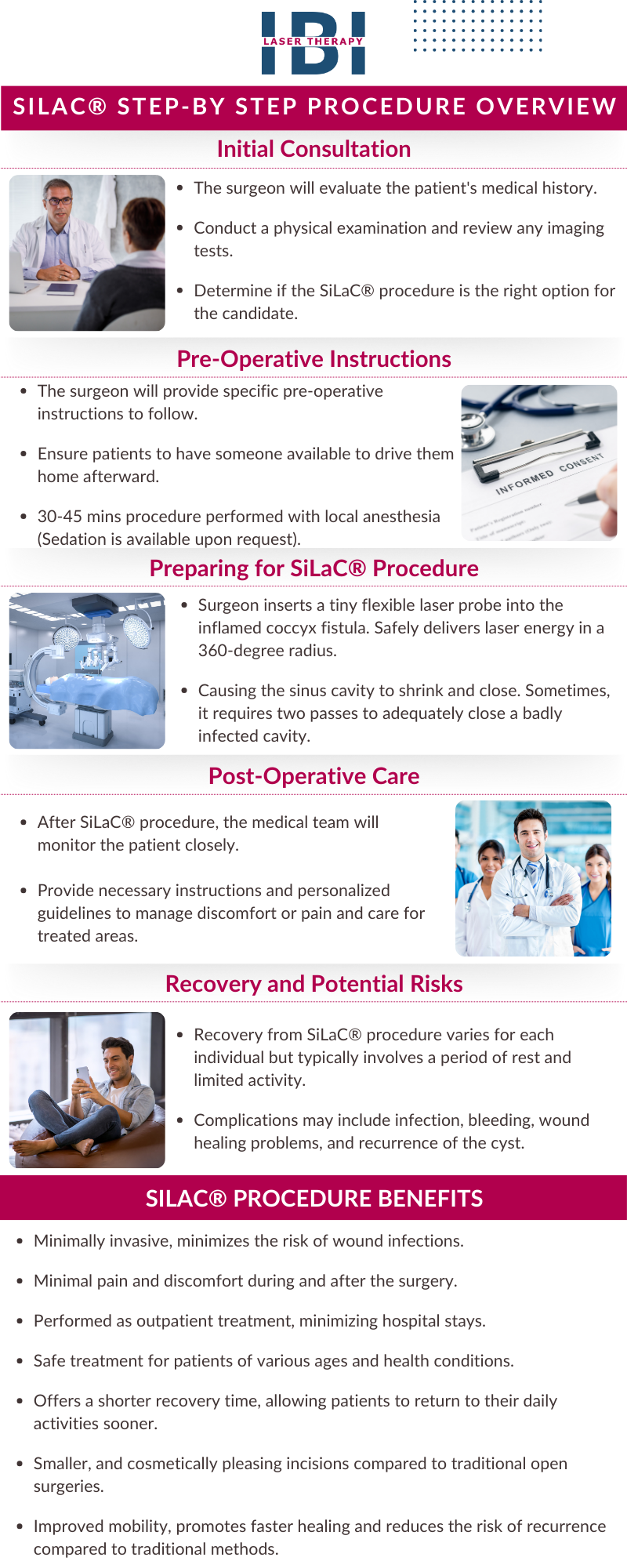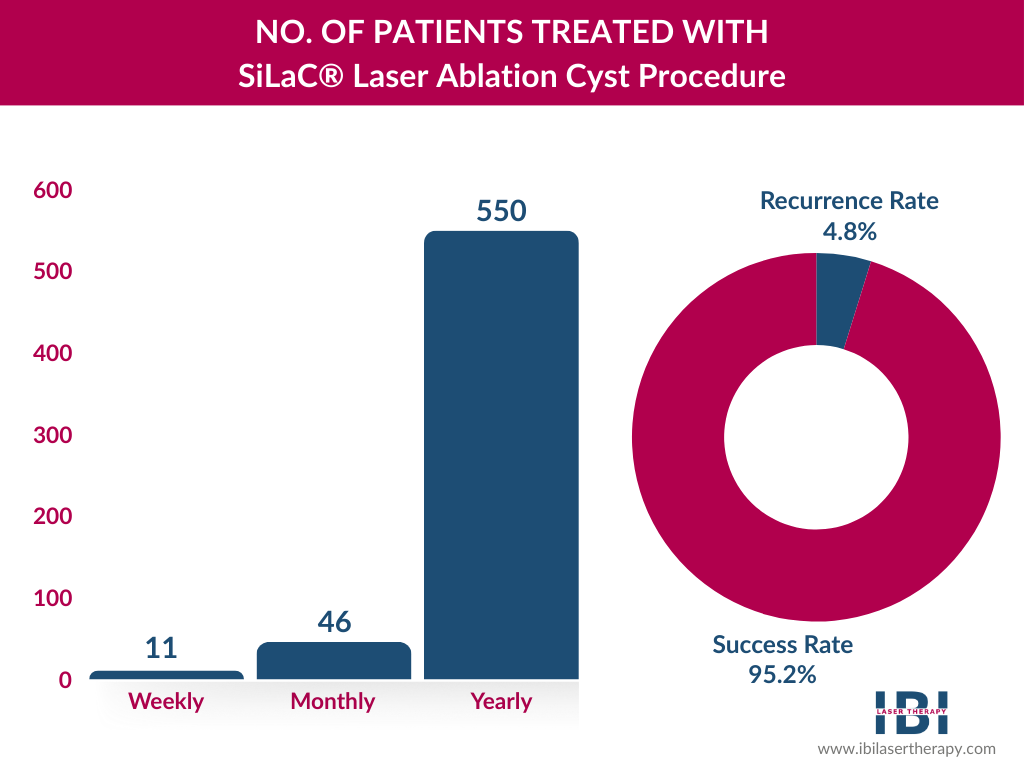Pilonidal Disease Management Treatment SiLaC®
- Home
- /
- Our Services
- /
- Cyst Removal Treatment SiLaC®
Pilonidal Disease Management Overview
Correspondingly, explore surgical and non-surgical Pilonidal Disease Management. In the same way, discover pilonidal cyst procedure SilaC® benefits treating different types of cysts. Not to mention, cysts can develop in various parts of the body, often filled with fluid, air, or other substances. Furthermore, they can occur in tissues, organs, or beneath the skin. Moreover, they can vary in size, ranging from tiny lesions to large masses, and may or may not cause symptoms.
While many cysts are harmless. On one hand, they may resolve on their own. But some may require medical intervention depending on their size, location, and associated symptoms. Generally, the diagnosis involves physical examination and imaging tests. For instance, ultrasound or MRI, and sometimes biopsy for further evaluation.
Pilonidal Cyst Overview
Pilonidal cysts typically resemble large, fluid-filled pimples. They develop near the tailbone and can become infected, causing pain, swelling, and drainage of pus.
Pilonidal Cyst Symptoms, Causes, and Risk Factors
Pilonidal cysts appear as small bumps at the top of the buttocks in the first place. Though, hair follicles become irritated or blocked, leading to the formation of cysts. Later, these cysts may become inflamed, leading to pain, redness, swelling, and drainage of pus or blood.
Nevertheless, common symptoms of pilonidal cysts. Furthermore, includes pain, tenderness, swelling, redness, and drainage of pus or blood from the affected area. As a matter of fact, some patients may experience fever or discomfort if the cyst becomes infected. However, a few factors may increase the risk of developing pilonidal cysts:
Complications of Pilonidal Cyst if Left Untreated
To say nothing of, if left untreated, pilonidal cysts can lead to various complications, including:
Abscess Formation
Pilonidal cysts may become infected, forming abscesses filled with pus. Undeniably, abscesses can cause severe pain, swelling, and fever.
Chronic Infection
Recurrent infections and inflammation of pilonidal cysts can result in chronic pain. Additionally cause ongoing discomfort and drainage.
Sinus Tracts
Pilonidal cysts may develop sinus tracts or tunnels beneath the skin's surface. Leading to the formation of recurrent abscesses and drainage.
Pilonidal Cyst Available Treatments
Indeed, depending on cyst severity, the surgeons recommend the treatment. Certainly, in a few instances, patients may require surgical intervention. Especially, when cysts become severe with abscesses and sinus cavities, surgical intervention becomes necessary. In like manner, surgeons use various techniques to excise the cyst, diseased tissue, and sinus. Henceforth, the recovery period can extend up to 3 months. Thus, less serious pilonidal cyst treatments include:
Injections
Injections help reduce inflammation. In the final analysis, the procedure can help shrink the size of the cyst. Additionally, reduces discomfort and promote healing.
Drainage
The procedure involves the removal of pus or fluid from the cyst to remove pain, pressure, and swelling. Whereas, surgeons perform simple incision and drainage procedures.
Sitz Baths
Sitz baths are a holistic treatment to cure cysts. It involves sitting in warm water to promote healing. Moreover, the procedure keeps the affected area clean and provide relief.
Laser Hair Removal
It targets and destroys hair follicles in the affected area. Reducing the risk of hair follicle irritation, eliminates the underlying cause of ingrown hairs and cyst formation.
Antibiotics
Antibiotics and pain medications control bacterial growth within the cyst and surrounding tissue to reduce the infection from spreading. However, they can only provide temporary relief.
SiLaC® Laser
SiLaC® (Sinus Tract Excision) is a minimally invasive procedure. Offers faster recovery compared to traditional surgical techniques with a reduced risk of recurrence.
Non-Surgical Cyst Removal Treatment
The SiLaC® laser therapy removes the infected tissue as well as minimal tissue disruption. Unquestionably, at IBI Laser Institute, surgeons have a meticulous approach to treating severe cysts.
SiLaC® Laser Ablation Cyst Procedure
In light of this, here’s our step-by-step procedure overview to ensure patients’ smooth recovery and successful procedures.

SiLaC® Pilonidal Cyst Success and Recurrence Rate
Due to its non-surgical and minimally invasive nature. By the same token, the Sinus Laser Ablation of the Pilonidal Cyst SiLaC® is suitable for almost every patient. Of course, anyone suffering from painful boils, abscesses, or cysts at the base of their tailbone (coccyx). Hence the right candidate for the laser procedure.
Factors Influencing Success Rates
- Equally, important, is the skill and experience of the surgeon performing the SiLaC® procedure. Subsequently, plays a crucial role in achieving successful outcomes.
- Comparatively, the severity and extent of pilonidal disease can impact the success of SiLaC® surgery. Likewise, early intervention for less advanced cases has better results.
- Positively, at IBI Laser Institute, we have a 95.2% Success Rate. To emphasize, our surgeons provide customized plans for patients to follow post-operative care instructions diligently. Finally, making sure that wound care, activity restrictions, and medication can contribute to successful healing.
Likelihood of Recurrence
- If the surgeon does not completely remove the pilonidal cyst and sinus tracts during surgery. Then, there is a higher risk of recurrence.
- Further, at IBI Laser Institute, surgeons perform a thorough excision to minimize this risk. Therefore, we have only a 4.8% Recurrence Rate among all the patients treated so far.
- Additionally, our surgeons schedule regular follow-up appointments. Following the subsequent treatment rounds, if required. Consequently, ensuring faster recovery of the treated area and early detection of recurrence signs or complications.

SiLaC® Video Testimonial
SiLaC® Procedure Cost, and Insurance Coverage
Provided that, on average, patients can expect to pay between $5,000 and $10,000. Given that, SiLaC® surgery includes surgeon fees, facility fees, anesthesia, and follow-up care. However, we’re currently running a promotional campaign, offering the SiLaC® procedure at a special price. To repeat, it is subject to a limited period.
Although, many health insurance plans may cover SiLaC® surgery if it is medically necessary. Equally importantly, our patient experience team assisted many patients with their respective insurance providers. To clarify, determining coverage eligibility, including any pre-authorization requirements.
Since patients seeking alternative payment options. Above all, we offer flexible financing options. Without a doubt helping patients manage the cost of the SiLaC® procedure without feeling overwhelmed. Last but not least, providing treatment is more accessible to patients. Besides this, explore our wide range of insurance coverage and financing options.
